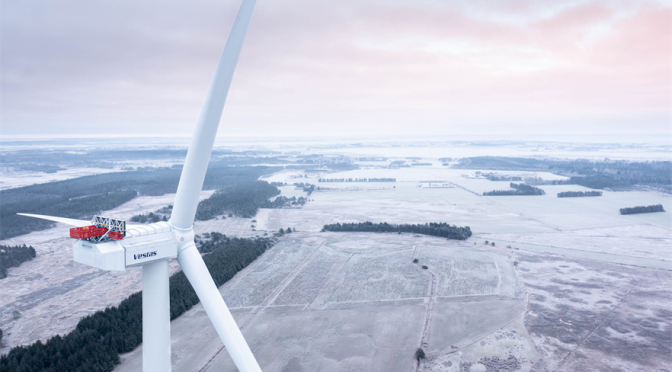ZF Wind Power is committed to driving a sustainable future with its partners and launches the first complete V236-15.0 MWTM powertrain.
The Vestas propulsion system is transported from ZF Wind Power Belgium to its destination in Denmark by sea.
Series production of this 15 MW propulsion system for the offshore wind market will begin at ZF Wind Power Lommel in the first quarter of 2024.
ZF Wind Power and Vestas respond to current and future growth in the offshore market with the V236-15.0 MWTM powertrain. The first prototype left Belgium via sustainable water transport.
Demand for wind energy is increasing around the world and turbines are becoming larger and more powerful. As a result, the propulsion system, the heart of the turbine, is also growing. With the expansion of ZF Wind Power’s portfolio from series production of gearboxes to series production of propulsion systems, not only will manufacturing processes be adapted, but transferability will also be improved. The company is investing in sustainable water transport.
The V236-15.0 MWTM powertrain: challenging the limits Powered by a swept area of 43,742 m², the Vestas V236-15.0 MWTM turbine pushes the boundaries of offshore wind energy production. A single turbine can produce up to 80 GWh per year depending on specific site conditions. This is equivalent to the annual use of 20,000 homes*. These models will accelerate the shift from climate-damaging fuels to clean, renewable types of energy. The blades are 115.5 m long.
Allow greater wind energy production with fewer wind turbines. This design not only challenges the limits of energy production, but also the limits of transportation. “Bridges, roundabouts, construction sites and other possible obstacles on the route make it quite difficult to transport such a heavy and large propulsion system on the road. After different studies with multiple experts, including De Vlaamse Waterweg nv (Flemish Waterways plc), we decided to transfer this unique design through inland waterways and international shipping,” explains Felix Henseler, CEO of ZF Wind Power.
Promote a sustainable future together through water Transport on navigable waterways is not only independent of obstacles. As there are hardly any “traffic jams”, it is more reliable and delivery times are predictable in detail. “Inland waterway transport is a very reliable mode of transport: you know exactly when your shipment will arrive. The goods are not only transported efficiently, but also in an environmentally friendly manner,” says Chris Danckaerts, Managing Director of De Vlaamse Waterweg nv. From 2024, ZF Wind Power will move engines by barge daily from the Lommel plant to the port of Antwerp. In Antwerp, a sea vessel will be fully loaded with propulsion systems on its way to its destination. If they had been transported one by one by road, the time and costs would be much greater. “Transport by waterways allows us to optimize logistics processes and, at the same time, contribute to a more sustainable future,” summarizes Felix Henseler.
Not only is the price of transport by shipping vessels competitive, but the social costs are also low. Lower fuel and labor costs ensure that the overall picture is two to three times lower than with road or rail transport. “The combination of inland shipping and shortsea transport offers many advantages and new opportunities for ZF Wind Power. By opting for inland shipping, they can not only save costs, but also achieve a significant CO? reduction,” says Chris Danckaerts. Transport by these vessels results in substantially fewer CO? emissions than the alternatives. By transporting more goods by water, trucks are taken off the road, and less particulate matter is produced. “This transport approach fits perfectly into ZF’s ambitious climate strategy,” says Dr. Michael Karrer, Head of Sustainability and EHS at ZF. “Our strategy covers not only ZF itself and our production, but also the emissions of the entire value chain. Therefore, we will also reduce emissions from shipping processes.”
For ZF Wind Power, water transport opens doors for the future. “With a quay only three kilometers from our plant, there are opportunities to send and receive more and larger products or components from and for our partners. Together, we can empower a sustainable future,” concludes Felix Henseler.
*Calculation is based on nameplate capacity divided by energy consumption excluding losses using Eurostat 2021 data
Captions:
- ZFWindPower_empoweringasustainablefuturetogether_viawater.mp4 – ZF Wind Power empowers a sustainable future together with its partner by replacing classic road transport with more sustainable water transport.
- ZFWindPower_ V236-15.0 MWTM.jpg – The Vestas V236-15.0 MWTM turbine moves the boundaries of offshore wind energy production forward. A single turbine can produce up to 80 GWh per year. (©Vestas)
- ZFWindPower-Powertraintransport-1.tif, ZFWindPower-Powertraintransport-2.jpg & ZFWindPower-Powertraintransport-3.jpg – The large design of the powertrain not only challenges the boundaries of energy production, but also the limits of traditional transport.


